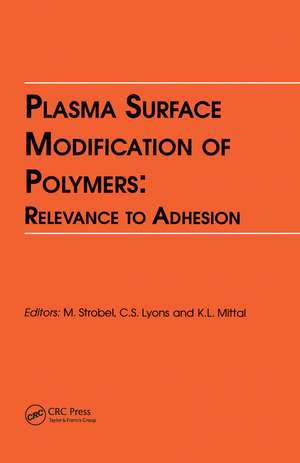Plasma Surface Modification of Polymers: Relevance to Adhesion
Editat de Kash L. Mittal, M., Lyonsen Limba Engleză Paperback – 2 dec 2019
In contrast to plasma polymerization, plasma surface modification reactions do not cause thin-film deposition, and can therefore only modify the surface properties of organic substrates. Plasma surface modifications are fast, efficient methods for improving the adhesion properties and other surface characteristics of a variety of polymeric materials.
The focus of this volume is on adhesion phenomena, surface properties and the surface characterization of plasma-treated materials. This book opens with a critical review of the plasma surface modification of polymers for improved adhesion. The remainder of the papers are divided into two sections, one dealing with the characterization of plasma-treated surfaces and the second concerned with various practical applications of plasma-treated surfaces
Preț: 352.95 lei
Preț vechi: 454.60 lei
-22% Nou
Puncte Express: 529
Preț estimativ în valută:
67.54€ • 73.34$ • 56.74£
67.54€ • 73.34$ • 56.74£
Carte tipărită la comandă
Livrare economică 23 aprilie-07 mai
Preluare comenzi: 021 569.72.76
Specificații
ISBN-13: 9780367449469
ISBN-10: 0367449463
Pagini: 290
Dimensiuni: 156 x 234 mm
Greutate: 0.45 kg
Ediția:1
Editura: CRC Press
Colecția CRC Press
ISBN-10: 0367449463
Pagini: 290
Dimensiuni: 156 x 234 mm
Greutate: 0.45 kg
Ediția:1
Editura: CRC Press
Colecția CRC Press
Public țintă
Professional Practice & DevelopmentCuprins
Part 1: Technology Review 1. Plasma surface modification of polymers for improved adhesion: A critical review Part 2: Characterization of Plasma-treated Surfaces 2. XPS studies of in situ plasma-modified polymer surfaces 3. Multitechnique study of hexatriacontane surfaces modified by argon and oxygen RF plasmas: effect of treatment time and fimctionalization, and comparison with HDPE 4. Plasma surface modification of polyethylene: short-term vs. long-term plasma treatment 5. Plasma oxidation of polystyrene vs. polyethylene 6. Evolution of the surface composition and topography of perfluorinated polymers following ammonia-plasma treatment 7. Surface fluorination of polyethylene films by different glow discharges. Effects of frequency and electrode configuration 8. Reactivity of a polypropylene surface modified in a nitrogen plasma Part 3: Practical Applications of Plasma-treated Surfaces 9. Chemical reactions on plasma-treated polyethylene surfaces 10. Immobilization of polyethylene oxide surfactants for non-fouling biomaterial surfaces using an argon glow discharge treatment 11. Plasma surface treatment of poly(p-phenylene benzobisthiozol) fibers 12. CO2 plasma modification of high-modulus carbon fibers and their adhesion to epoxy resins 13. Oxygen plasma modification of polyimide webs: effect of ion bombardment on metal adhesion 14. Enhancement of the sticking coefficient of Mg on polypropylene by in situ ECR-RF Ar and N2 plasma treatments 15. Improved adhesion between plasma-treated polyimide film and evaporated copper
Descriere
This book focuses on the plasma or glow-discharge, which can be defined as a partially ionized gas normally generated by an electrical discharge at near-ambient temperatures and reduced pressures. It discusses adhesion phenomenon and the surface characterization of plasma-treated materials.
